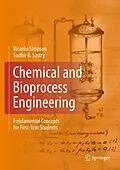This is a unique introductory textbook that covers all aspects of both chemical and bioprocess engineering and provides a thorough grounding in the fundamentals so that the background may be used in future work. Included are more than 400 proposed and solved exercises, each classified by its level of difficulty. Each chapter contains references and selected web pages to vividly illustrate examples. To aid the reader, each chapter is marked according to Bloom's Taxonomy to indicate the level of attention given to each concept.
About the Authors
Ricardo Simpson is a Professor at the Universidad Técnica Federico Santa María, Department of Chemical and Environmental Engineering, Valparaíso, Chile.
Sudhir Sastry is a Professor at The Ohio State University, Department of Food, Agricultural and Biological Engineering, Columbus, Ohio, USA.
Autorentext
Ricardo Simpson, Professor, Universidad Técnica Federico Santa María, Department of Chemical and Environmental Engineering, Valparaíso, Chile.
Sudhir Sastry, Professor, The Ohio State University, Department of Food, Agricultural and Biological Engineering, Columbus, Ohio, USA.
Klappentext
The goal of this textbook is to provide first-year engineering students with a firm grounding in the fundamentals of chemical and bioprocess engineering. However, instead of being a general overview of the two topics, Fundamentals of Chemical and Bioprocess Engineering will identify and focus on specific areas in which attaining a solid competency is desired. This strategy is the direct result of studies showing that broad-based courses at the freshman level often leave students grappling with a lot of material, which results in a low rate of retention. Specifically, strong emphasis will be placed on the topic of material balances, with the intent that students exiting a course based upon this textbook will be significantly higher on Bloom's Taxonomy (knowledge, comprehension, application, analysis and synthesis, evaluation, creation) relating to material balances.
In addition, this book also provides students with a highly developed ability to analyze problems from the material balances perspective, which leaves them with important skills for the future. The textbook consists of numerous exercises and their solutions. Problems are classified by their level of difficulty. Each chapter has references and selected web pages to vividly illustrate each example. In addition, to engage students and increase their comprehension and rate of retention, many examples involve real-world situations.
Inhalt
Introduction.- Fundamentals of Magnitudes, Units Systems, and Their Applications in Process Engineering.- Fundamentals of Process Control, Communication, and Instrumentation.- Learning from Nature and its Applications in Chemical and Bioprocess Engineering.- Challenging and Solving Problems with Basic Tools, Testing Student's Attitude.- A Glimpse of Thermodynamics and Transport Phenomena.- Fundamentals of Material Balances (Non-reactive Systems).- Fundamentals of Material Balances (Reactive Systems).- Fundamentals of Mathematical Modeling, Simulation, and Process Control.- Scale Up in Chemical and Bioprocess Engineering.- Optimization and Chemical/Bioprocess Optimization.- Basic Economic Principles and a Glimpse on How to Take a Decision Among Alternatives.
